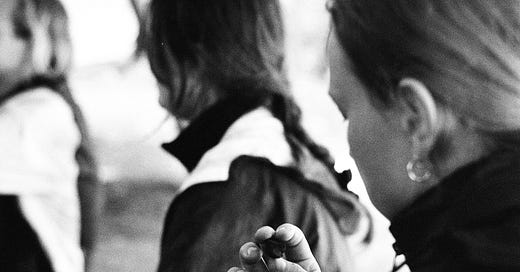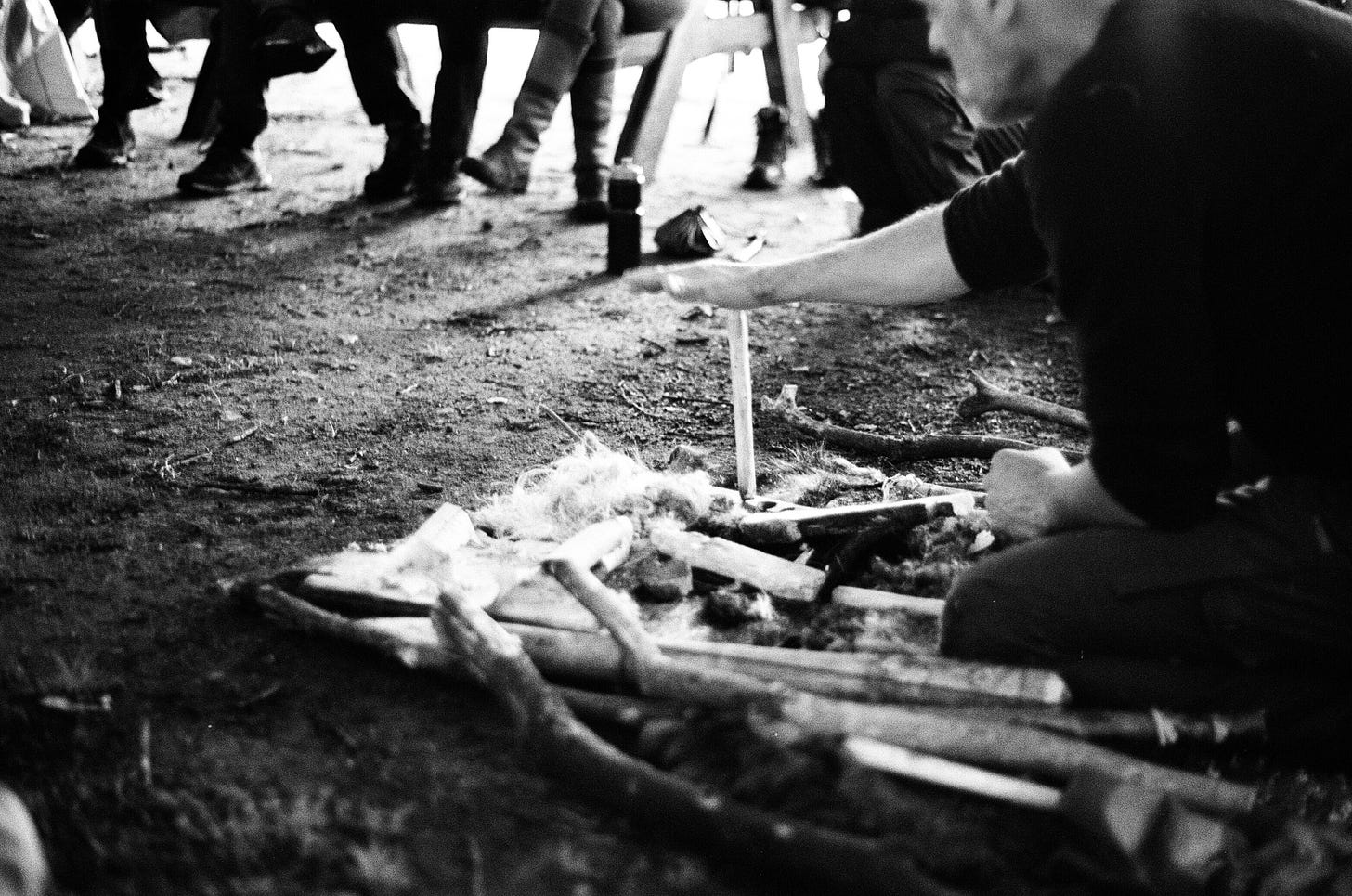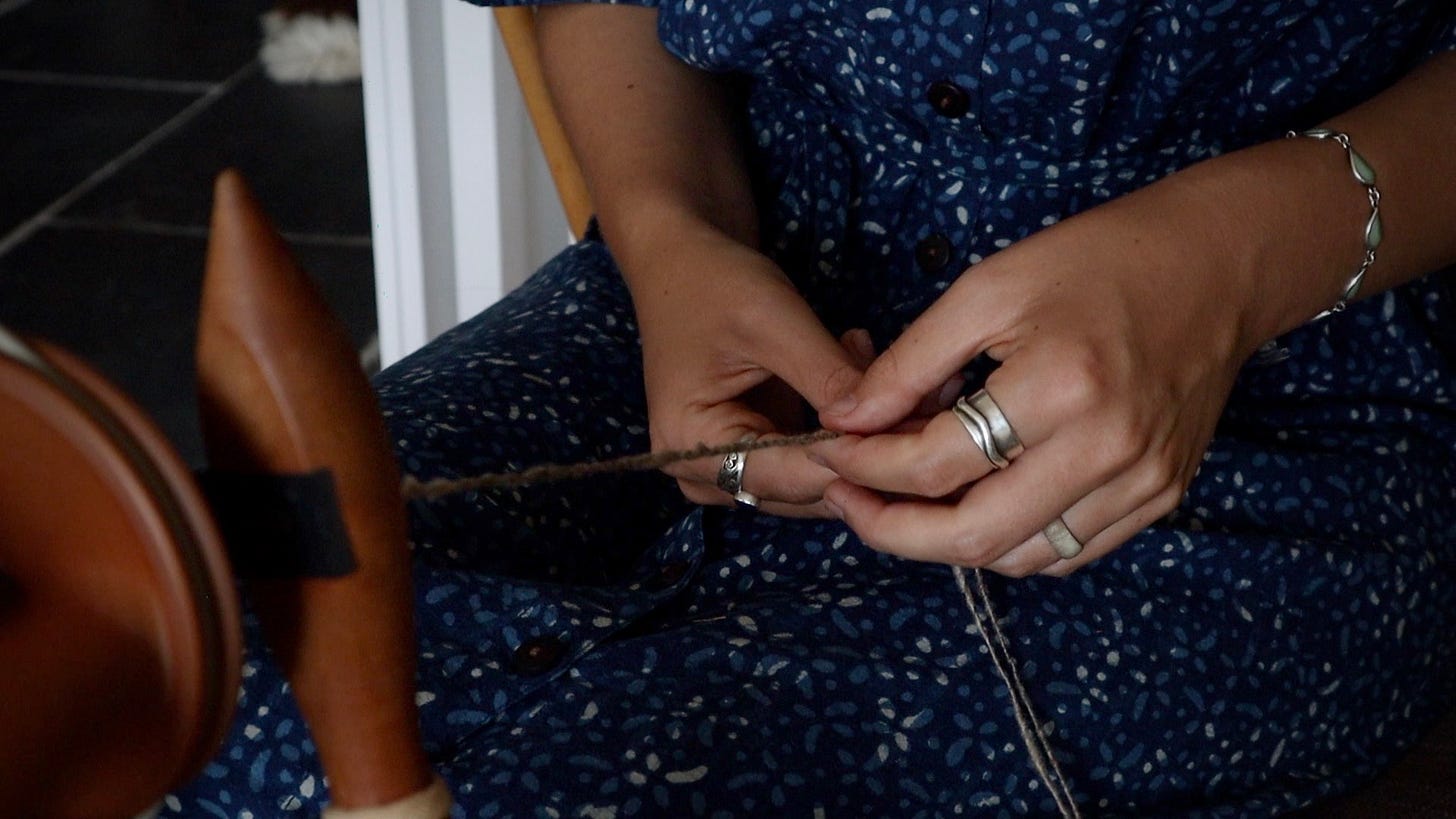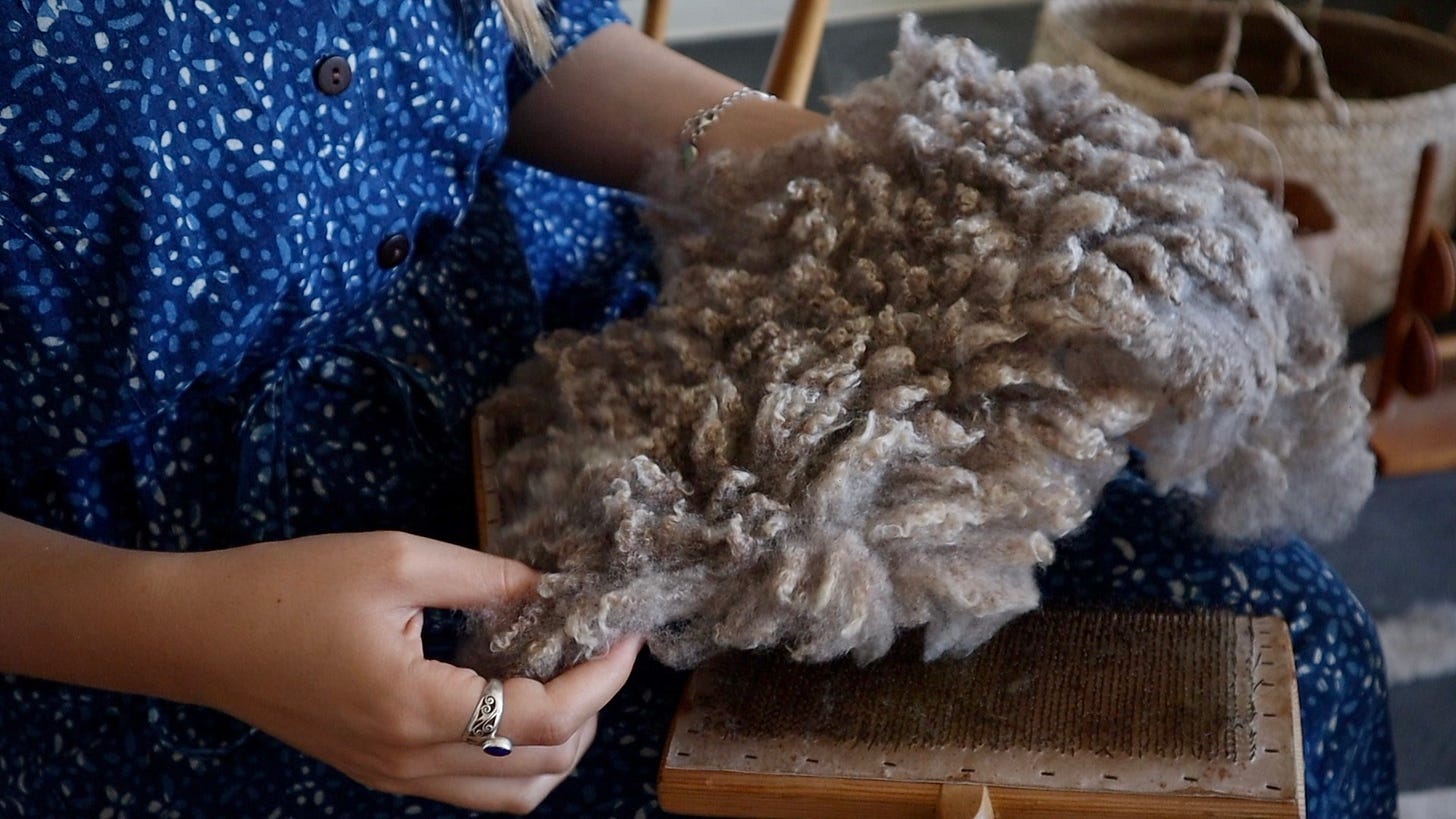I’ve realised over the past years that my hands need a lot of time re-membering, in a literal sense, what they were created to do, the purpose they’ve been largely estranged from in the modern world. Kneading dough, seeding soil, spinning wool, gathering berries, tending fire. They’re hands devoted to beauty’s infinite incarnations in material form and the strange ways in which the functionality of care — the everyday maintenance work of caring — in its many, many manifestations becomes beautiful by design (think of the art of the tea ceremony, the intricately hand-knitted scarf you received for Christmas to keep you warm, the pleasure of tasting food cooked with skill but also with love). Form and function eternally wedded. This is where the borders artificially constructed between ‘art’ and ‘craft’ begin to dissolve. We are creatures born to make, and born to make beautifully.
How, then, do we orientate ourselves in an age of bombardment with cheap, mass-produced commodities, devoid of intentionality and care and skill in their making? The age of stuff. The earth creaks under the weight of it all. We collectively worship the material, but too often that which has been reduced to a one-dimensional existence in our eyes; if we can throw money at it, if its trendy, we’ll have it. We’ll demand to have it. We live in an era which has commodified the labour of making in itself — whether food, textiles, furniture, tools, or treasures far beyond our basic necessities — and wrung it out of the rhythms of our daily lives under the suspiciously sleek and shiny guise of convenience. Our earthly bodies are taught to function as machines if they are to produce anything of economic value. Conform to the standards of an industrial model of production (uniformity, productivity, efficiency = profit) or, worse still, become redundant entirely.
I wonder if what we’ve lost, that which slipped away so quietly, is the art of livelihood. The simple, creative rituals of material world-making that once shaped our everyday lives with beauty and sustenance both; the vernacular language of craft familiar the world over, spoken by many but also heard, received and inherently valued. The hand-knitted jumper that’s been repaired a dozen times and still carries the distinctive earthy musk of lanolin that only a particular sheep in a particular fold of lush pasture could create. The hand-turned fruit bowl on the dresser still taking pride of place, stained with generations of use and gathering dust in its contours. The jars of colourful preserves lining cellar shelves, drawing out the space between summer abundance and winter dormancy. The many ‘things’ born from the magic of ritually tending to spaces, bodies, relationships. The foraged and found, that which is whittled into new forms by our hands, mended with care or gifted with love in turn.
I’m not intending to romanticise the hardships and drudgery undoubtably embedded in the livelihoods that came before ours, but I do know that something was relentlessly stamped out in the pursuit of progress that came to define our modern lives, something intimately relational that once bound us to the specific textures of our local environments, our hearths and homes, our tapestry of human and more-than-human kin. Though most of us are no longer crafting, making with our hands, out of necessity, the process is still an echo of a time when our livelihoods depended upon it; we nurture a still-burning desire for this deeper and more meaningful connection to the tangible, this embodied relationship between place and material and maker that carries deep, deep time in its folds. Perhaps something in us clings to the memory of this — how head, heart and hands want to sing in unison, in service of something far beyond labour made sterile for the sake of mindless and boundless consumption alone.
This notion first came alive for me years ago, as I leafed through The Forgotten Arts & Crafts by John Seymour, a precious book detailing some of the dying traditional skills and trades of craftspeople across the British Isles in the 20th Century, from coopering to thatching to lace making1. A new kind of despair settled in my gut as I read biography after biography of the ‘last surviving…’ or ‘only recorded…’ masters of their trades, who must have carried their wisdom to the grave, possibly never to be revived.
But, importantly, rather than relegated to the realm of experts or masters alone, Seymour sketches a world in which handcrafts were at the very heart of households and rural life in general. This calls to mind the significant and understated role that women played (and still play) as carriers of culture, tangible and intangible, for millenia; the weavers, potters, bakers, spinners, circling the hearth across disparate geographies and times, singing as they worked. I think of the entrancing waulking songs of women on the Isle of Harris in the northwest of Scotland, working the tweed to loosen the woollen fibres and singing to stay in time with each other, or the Basque ‘Iruten ari nuzu’, ‘I am making wool’, sung as a refrain whilst spinning rhythmically. Sylvia V. Linsteadt asks, “what does it mean when typically domestic, so-called domestic, crafts and activities and stories are actually seen as the center point of a culture? Because, my god, they actually are.”2 Despite an active silencing in written histories, this truth has always been celebrated through thread, story and song alike, which are, at their core, woven of the very same fibres, are they not? How ‘text’ and ‘textiles’ emerged from the same root. How we spin yarns and weave stories.
My hands must have remembered this, as my grandmother’s spinning wheel came into my possession and I began to twist the rich and various fibres of heritage breed wool into yarn, an activity that I stumbled over repeatedly until it felt entirely intuitive, the thread becoming a natural extension of my hands as they worked. And as I learned to weave, poorly, on the most basic of looms assembled from a few pieces of wood. As I baked dark, honeyed rye with caraway, a process made slow by the artful courting of natural yeasts. As I spent hours mending clothes dear to me in the hope that they wouldn’t leave me just yet. As I learned to make fire with damp wood in a hollow in the valley, to cook over that fire, to warm myself by that fire with gratitude as the endless rain crept into my bones.
What began as a benign intellectual curiosity, holding me at a distance, became an active conversation over time, one which I had given myself over to without realising, even if I didn’t need to physically. I let my hands morph slowly to welcome unfamiliar shapes and turned toward my local ecosystems for guidance in the process of feeding, clothing and caring for myself where possible, and in doing so I carried a sense of treading the well-worn cultural tracks of generations long before. I thought of my beloved grandparents, only two generations back, and how intelligently resourceful they were in a way I’d never fully appreciated, navigating life in the post-war period before the monopoly of supermarkets and online shopping. Most of us younger folks have never experienced the before. What we know is everything made instantly available, everything made disposable, and at what cost?
The eco-cultural philosopher James R. Martin writes,
“…industrial modernity not only displaced humans from their rightful and appropriate place as full, intimate partners in intimate relation to non-human animals and plants (and our food), but in doing so we lost a certain historical sense of the notion of livelihood, and this loss has been depriving us of the imaginative space in which we can properly respond to the polycrisis.”
He goes on to write,
“I think we moderns have a detached, displaced, disembodied, disenworlded notion of livelihood which is a conceptual and experiential outgrowth of displaced, hyper-industrial modernity. Modern economics mutated into an abstract version of an already largely abstracted set of theoretical constructs from its origins, resulting in the marooning of the embodied, earthy sense of Old English liflad (from “life” and “way” or “course”, which evolved into livelode, referring to how one’s life was sustained, for example through resources, provisions, occupations).
It began with the emergence of an invisible elsewhere, where the things we use daily (like food) became distant, invisible — elsewhere. The experiential and sensuous particularity of the life of liflad disappeared, robbing us of liflad. Eggs were—they became—from the grocery store. The gasoline in our cars was from a distant refinery. Maybe we’ve seen pictures of the refinery, but do we know its smell? Livelihood became literally displaced — removed from the places where we live, breathe and have our being. In this removal from our immediate experiential domain, we became uprooted, lost, ungrounded. Our liflad became an abstract idea, a notion, a picture — something perhaps you could smell if you happened to live at the Gulf of Mexico. Liflad is trucked in, flown in. It comes on container ships from China, on rails. You can learn about it on television, read about it in a book. It becomes numbers on a graph, some statistics in distant government buildings. Places disappeared, insofar as liflad goes. Every place is any place. No place is quite home.”3
The art of livelihood seems to emerge from the direct, material encoding of the relationship between body and place. It’s the very essence of intentionality and care that brings an object into being by necessity, in a world which understands, and celebrates, that so much is imbued in that object in the process: the memories, dreams and emotions of the maker married with the life force or spirit of the natural material itself, in ongoing conversation through time. Each transforms the other in an alchemy of sorts. This is an enlivened process at its core, the embodiment of creative potential in the most organic of forms and entirely unique in its expression each time. It cannot be replicated through the standardised, factory-produced goods wrought from polluting petrochemicals nor in items untethered from their far-away cultural contexts — the “distant, invisible elsewhere” as Martin describes — because they became fashionable consumer ‘products’ for sale on the global market. Liflad, as it was once known, carries the scent of damp earth, rusted metal and woodsmoke. It is carved from an old, old language, the branched limb of a grandmother yew. It is lived, felt, breathed through body and place instantaneously as it is brought into being.
There’s a shallowness to the material culture sold to us under industrial modernity, and once you notice its pervasiveness, it becomes difficult to discern what lies beneath the plasticised veneer draped across the aesthetic of our lives. The hunger for authenticity remains. Not authenticity referring to ‘tradition’ as fossilised past, dredged into the contemporary world as relic alone, but the ongoing, dynamic, reciprocal relationship that grounds us in place, connects us to source, and emulates that which our ancestors knew to be essentially true: the commitment to making a life, a livelihood, right here, neither importing it from abroad nor extracting it from beyond the respectful limits of earth’s offerings to us, if we can choose to do so. On the surface, we might observe and denounce the violent and ugly politics of fragmented supply chains within the workings of our capitalist economy. But beneath the surface, are we aware of and do we feel the absence of this intimacy and richness of embodied relationship? Maker, material, place. Storied worlds, rather than worlds made shallow and emptied of their substance. The lost art of livelihood is a poetic lament.
We may know how to make a living in order to consume — things, beings, experiences — but do we remember what it means to make a livelihood? Even just symbolically, even just a fragment of it?
Anthropologist Ann Armbrecht, in her book exploring the globalised supply chains of botanical products, draws on the work of philosopher Robert Pogue Harrison to describe the “lost art of seeing” in the contemporary world4. Harrison speaks of the laral value of an object: laral comes from lares, the Roman word for the everyday gods guarding the hearth and home, who abandon the house or community if left untended. The laral value of a thing arises through being in relationship with the world behind that thing, the necessary context that moulds the very dimensions of its coming-into-being. The seeing — depth perception, perception of the whole — that takes time and intention to cultivate but becomes a wellspring of innate value and pleasure in our lives. “What we see depends on history and culture as much as it does on the structure of our eyes,” Armbrecht writes, citing Harrison, “contemporary humans are less and less able to see the plentitude of the world.” We seem less able to appreciate the beauty in that which, if we’re quiet enough to hear it, whispers to us of an old knowing, a slow knowing, that which inhabits a world apart from the volumes of ‘content’ churned out across media platforms each day, demanding our attention. We’re less able to see the whole, and therefore less able to tend the whole.
To devote attention and patience to cultivating something that takes time is a privileged form of currency in a world which wants to squeeze productivity out of us in every waking moment. But one day, it might actually prove critical for our shared future, might become the thread that binds us to community and land for our survival as interdependent beings, when the economy as we know it cannot provide us with a tangible, viable livelihood. I wonder if we’re being invited to reinsert ourselves back into a narrative where livelihood resembles something much closer to liflad, deeply relational and rooted in place. To feel the lost art of livelihood — and here I refer to art as both process and product — is an initiation into a practice of rekindling beauty in our lives, however our hands and bodies so desire, however earth seems to invite us; the beauty of being in reverent relationship with the material world and making, crafting with our hands, honouring the particular vernacular of the creative impulse and the particular contours of the lands we inhabit, with a depth of awareness and devotion that we’ve become increasingly estranged from.
It’s an initiation into re-storying our material world, and our relationship to the material world, through intentionality. Everything is a repository: the food that we nourish our bodies with, the fibres that we adorn our bodies with, the matter that we assemble to decorate our homes and lives both functionally but also symbolically. Everything tells a story of its own. In a conversation with both the filmmaker and creator behind The Nettle Dress, a film following the painstaking process of hand-making (harvesting, processing, spinning, weaving, sewing) a garment from wild nettles, the talented maker Allan Brown speaks to how the cloth became storied, impregnated “with a sort of magic” which is “so different from the industrial model, where if those threads do carry stories, they’re probably aggressive stories of exploitation and loss and labour.”5 If we look closely, the weft always reveals the details. Can we get curious about what this means for all of us, as makers? Can we choose for the magic? Can we start where we are, and find our unique entry point back into the narrative bow that has held us through time, in which livelihood is something crafted beautifully, intimately and relationally? And with this remembrance we might deepen into place, deepen into time, deepen into the potential of our bodies as creative vessels, more fully.
John Seymour (1984) The Forgotten Arts & Crafts (London: Dorling Kindersley)
Sylvia V. Linsteadt (2024) ‘Transcript: SYLVIA V. LINSTEADT on The Motherline /363’, For the Wild podcast, https://forthewild.world/podcast-transcripts/sylvia-v-linsteadt-on-the-motherline-363
James R. Martin (2023) ‘Livelihood: a new and old idea’, Resilience, https://www.resilience.org/stories/2023-04-18/livelihood-a-new-and-old-idea/
Ann Armbrecht (2021) The Business of Botanicals (London & Vermont: Chelsea Green, p.108) and Robert Pogue Harrison (2008) Gardens: An Essay on the Human Condition (Chicago: Chicago University Press)
Allan Brown (2023) ‘#199 Making the Nettle Dress: a creative journey of attention, magic and loss with Allan Brown and Dylan Howitt’, Accidental Gods podcast, https://accidentalgods.life/making-the-nettle-dress-a-creative-journey-of-attention-magic-and-loss-with-allan-brown-and-dylan-howitt/








Possibly one of the most beautiful writing I have read on Substack. Thank you 🌻